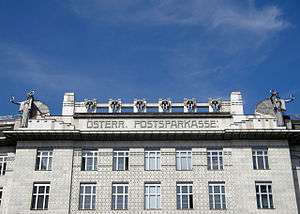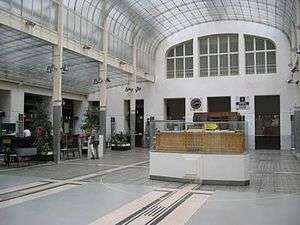Austrian Postal Savings Bank

The Austrian Postal Savings Bank building (German language: Österreichische Postsparkasse) is a famous modernist building in Vienna, designed and built by the architect Otto Wagner. The building is regarded as an important early work of modern architecture, representing Wagner's first move away from Art Nouveau and Neoclassicism. It was constructed between 1904 and 1906 using reinforced concrete.
It can be argued that the building is a continuation of traditional architecture with all its elements such as decoration, sculpture, an underlying order, primarily vertical composition, far different from the complete break with tradition that the congrès internationaux d'architecture moderne (CIAM) advocated in the 1920s.
The building houses the headquarters of the Österreichische Postsparkasse (P.S.K.) bank, formerly the k.k. Postsparcassen-Amt (Imperial-Royal Postal Savings Office). It is located at Georg-Coch-Platz 2, in the first district Innere Stadt, next to the Ringstraße boulevard.
Exterior
Up to eight stories high, the building occupies an entire city block. The massively simplified facade of the bank clearly owes something to classicism. Wagner's key idea was to celebrate modern materials by developing new forms. The entire facade is covered with square marble plates. These are attached to the main brick structure with mortar and ornamented with iron bolts with aluminum caps, which themselves form a pattern. The building's harmonious synthesis between form and functionality was highly acclaimed by critics. The metal rivets do not obstruct the facade but resemble decorative elements. The use of marble also makes the maintenance and cleaning of the facade very easy and inexpensive, another important functional element in Wagner's design. The architect kept the design very minimalistic and simple; his aim was to convey the sense of a strong, impenetrable bank in which customers would know their money was safe.
Only at the upper part of the exterior, near the roof, did Wagner add more elaborate decorations, such as statues of female angels holding laurels in both hands. These were sculpted by frequent Wagner collaborator and fellow Secessionist Othmar Schimkowitz.
Interior

Through the main entrance at Georg-Coch-Platz the visitor ascends a flight of stairs to the grand Kassenhalle, where customer services are located. The main hall is thus effectively on the first floor. The hall is designed like an atrium, with a large glass skylight allowing natural light to enter the heart of the building at all times. Natural light is not used only for stylistic reasons, but also to reduce the cost of electric lighting. Even the floor of the main hall is constructed of glass tiles, allowing natural light to reach further down to the floor below, where the Post Office boxes and mail sorting rooms are located. Wagner kept decoration in the main hall to a constrained minimum, using only glass and polished steel as materials. The decorative effect is created by the simple but elegant use of the material itself. The frosted glass skylight is pierced by steel columns, their slim design making them as unobstructive to the falling light as possible. The hall is one of Otto Wagner's most famous masterpieces, and one of the finest examples of the Viennese Jugendstil.
The building's office space is divided according to the axis of the outside windows, again making use of natural light as much as possible. The interior walls are non-load-bearing, and can therefore be re-arranged according to need, a feature that has become standard in modern office buildings.
Spared any damage during World War II, the building is still in its original state and includes a museum devoted to its creator, Otto Wagner since 2005.
Literature
- Otto Wagner. Die österreichische Postsparkasse. Falter Verlag, Wien. 1996. ISBN 3-85439-180-3
- Carl E. Schorske. Fin-de-Siècle Vienna: Politics and Culture. Vintage, London. 1980. ISBN 0-394-74478-0
External links
- Otto Wagner Museum located within the Austrian Postal Savings Bank
- Virtual tour through the building
Coordinates: 48°12′36″N 16°22′49″E / 48.21000°N 16.38028°E